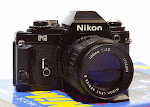The focal length you chose will determine how large the image forms on your film or digital sensor.
Example: Shooting with a 135mm lens 10 feet away from your subject will form a larger image on your film plane or sensor than shooting with a 35mm lens from the same distance.
Another way to look at the focal length: A 200mm lens will produce an image twice as high and twice as wide as a 100mm lens. A 100mm will produce an image twice as high and twice as wide as a 50mm lens. And so forth.
How do we measure the focal length of any given lens? The answer is simple. There are three ways to measure the focal length of a lens, inches (in.), centimeters (cm), and millimeters (mm). Millimeters are the most common measurement for 35mm lenses.
There are about 25mm to an inch so a 55mm lens would be the equivalent of a 2.2 inch lens, or there about,a 50mm lens about 2 inches as pictured below.

LENS APERTURES
I have discussed the aperture (iris) opening in a previous post. I covered how a large opening admits the most light and the larger the opening the faster the lens.
Samples of aperture openings.


Lets take a closer look at the aperture and how it relates to the focal length of a lens.
In photography we are not just interested in how much light enters the camera. Our concern is how much light reaches the film or digital sensor. This is determined on how far the lens is from the film or digital sensor.
The closer the lens is to the film or sensor the more potent the light source will be. The farther the lens the less potent the light source becomes.
Example: Take two lenses with the same size aperture. Both lenses will let the same amount of light in. If both lenses are the same distance from the film or digital sensor they will each let the same amount of light reach the film or sensor. What happens if one lens is closer than the other?
Lenses with short focal lengths are shorter in length than those with larger focal lengths. Being that a short focal length lens is shorter in length also means that is sits closer to the film or digital sensor. If its closer to the film or sensor it will allow more light to reach the film or sensor than the longer focal length lens.By using various focal lengths we can control the amount of light, which reaches our film or digital sensor. Is this practical? Do we have other options? The answer is “yes”.
We could simply vary the size of our aperture.
We don’t have to calculate our exposure by relating the two variables. (Focal length and aperture). A system has been designed that combines both variables into one number; the f-number system.
An aperture of f/5.6 lets a specific amount of light reach your film or digital sensor. Any lens set at f/5.6 will admit the same amount of light to your film or sensor. Let your exposure meter tell you what f/stop to use then set your lens to the appropriate number. This will apply to all focal lengths.
The f/stop system allows you to calculate proper exposure regardless of the camera or lens you are using. The f/stop is an important tool, a tool you will use extensively in photography.

No comments:
Post a Comment